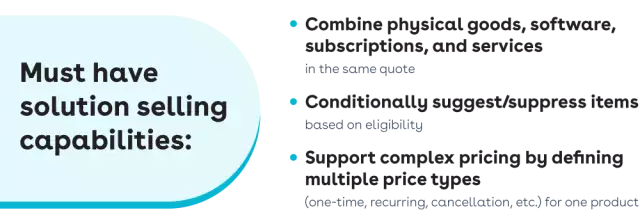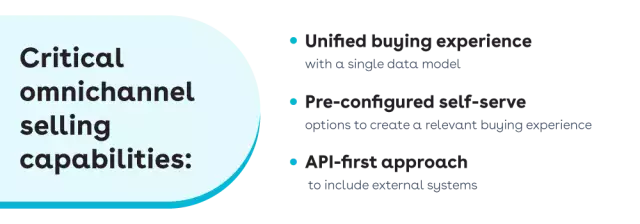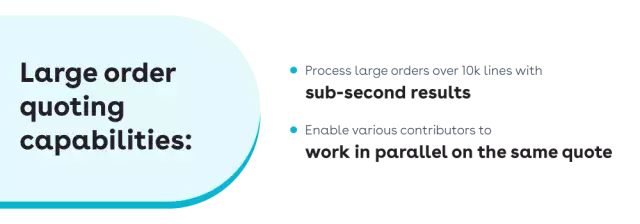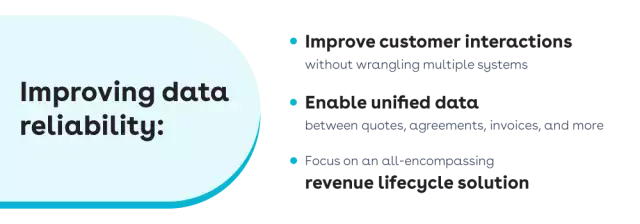
5 ways CPQ helps enterprises capitalize on B2B commerce changes

B2B businesses are changing. Customers want B2C-like experiences, seamless omnichannel interactions, and faster performance. These changes have led to big challenges but also created opportunities to thrive for those who shift strategies with these changes--which is why Configure, Price, and Quote (CPQ) software matters for enterprise businesses today.
For forward-thinking organizations with intricate products, complicated pricing, and manual processes, CPQ can be a meaningful change. This blog post will examine five trends in B2B commerce, the challenges they pose, and how a CPQ solution could help you solve them at your organization.
We recently covered this topic in a webinar if you prefer to watch a video. Watch the full webinar recording here.
1. Solution selling
Solution selling is the most common strategy for building an all-encompassing offering for B2B customers. This is when a combination of multiple products and services are bundled and sold together to create an overarching solution. Typical packages may include hardware, software, service, recurring charges, multi-level configurations, and more based on the customer's expanding needs. As businesses move towards XaaS (anything-as-a-service) revenue strategies, solution selling becomes imperative.
For more on solution selling, check out our Solution Selling Ultimate Guide.
Challenge:
While solution selling has many positives, this strategy can be hard to implement because many systems don’t allow the combination of subscription-based and one-time products on the same quote. Subscriptions are often treated separately from one-time billing invoices. Customers don’t get an easy to do business with experience. Instead, they are inundated with multiple quotes and invoices for what was sold to them as an all-encompassing solution.
Check out this clip from our Conga experts for a deeper look into the challenges of solution selling and some industry-specific examples.
Solution:

To help simplify this process, a CPQ solution can manage different types of products and services on one quote. Line items like physical products, services, and subscriptions that are typically disconnected can all live together within the system, be added to the same quote, and be billed on the same invoice. A CPQ tool can also see beyond the current configuration. Product rules ensure specific solution attribute selections or account values are applied to all bundles on the quote, such as design standards, voltage, and country of deployment. One product or service can also be managed with multiple price types to avoid SKU proliferation. This provides support for complex products and pricing rules.
2. Omnichannel selling
Businesses looking to sell across multiple channels may employ an omnichannel selling strategy. This entails multiple sales channels, such as direct, indirect, and self-service options. Customers want a self-serve experience like an eCommerce site, Partners want a Partner Portal, and internal teams like Customer Service or Support wish to be connected to the sales cycle. Omnichannel aims to create a seamless buying experience where channels are connected, allowing users to start an order in one and finish in another.
Challenge:
With an omnichannel eCommerce strategy, an internal salesperson will not always be there to walk customers through the correct configuration. Customers need to be guided through the configuration process. It’s challenging to surface the correct options and only the relevant items to which the customer is entitled. It’s not as easy as putting the catalog online and saying, “Have at it.” There are many rules needed.
Additionally, when selling through a partner network, you want those partners to utilize the same information and rules so a customer sees the same information through a partner that they would if they worked with the company directly. Similarly, as customer success is walking through a change or an addition, they need the same information. Different channels cannot have different product and pricing sources and rules engines; otherwise, the data will differ.
Solution:

With the help of a CPQ tool, customers can enjoy a more unified experience across different channels while businesses know the data is accurate. A CPQ enables all channels to tie back to the same system with one product master, pricing source, customer master, and rules engine. Customers will experience unification of buying as channels are connected, allowing them to start in one and finish in another. For self-service customers, the CPQ tool will also enable you to guide their buying process, suggest configurations, add visualization, and make additional information available so they can make the proper selections.
The CPQ solution must integrate seamlessly with existing revenue and commerce systems, such as CRMs and ERPs. A CPQ with an API-first approach allows configuration, pricing, or quoting capabilities to be embedded into eCommerce, direct sales, and partner portals, helping streamline configuration and pricing across the revenue lifecycle.
For more on the role of CPQ in enhancing B2B eCommerce, check out the blog Maximizing your B2B eCommerce potential with a CPQ solution
3. Large orders
Quote sizes are increasing as additional options are added to increase the customer lifetime value. Today, we have customers who produce quotes with 5,000 to 12,000 lines. The ability to handle large quotes directly reflects your business’ performance, from how fast the quote is created to how accurate it is.
Challenge:
The time it takes to get a customer a quote is a significant determining factor in who wins the sale. When larger order requests come in, keeping performance on track can be extremely challenging. Speed and accuracy can suffer greatly without an easy way to quote the request. Some quotes have many line items, and some quotes have levels of complexity in the configuration that are multiple levels deep, and everything depends on each other. Size, complexity, or a combination of both can slow things down dramatically.
Large orders also often require extensive internal collaboration and input from different teams and departments, further slowing the quoting process. Manual approval processes that may be affected by people out of the office also delay the quoting process, lengthen the sales cycle, and ultimately result in increased lost deals.
Solution:

A CPQ tool helps process, measure, and manage large orders easily to ensure your customer stays happy and informed throughout the quoting process. A solution built with an API-first approach that can process rules on a separate platform will allow you to configure, process, and price large orders in minutes with automated pricing rules and thousands of configurable attributes. With a high-performing CPQ tool, you can process 10,000 line items in one quote, support multiple small bundles versus one giant bundle, and manage attributes for a larger number of products with more variations. Users no longer wait minutes to verify configurations or update the pricing of very large orders.
A CPQ tool should also allow multiple teams to collaborate within the same quote, with automated approval notifications and tandem review cycles. Set up specific trigger approvals for custom objects based on criteria that support company policies. Automated approvals improve the selling experience for both the seller and the customer by increasing deal velocity and accuracy.
4. Data reliability
Making sales without correct data is challenging, let alone making decisions about your company's future. Incorrect or incomplete data increases risk in the business and creates longer sales cycles for customers.
Challenge:
It is time-consuming to aggregate all your information into one single source of truth. It’s a huge efficiency drain to wrangle multiple systems to understand what a customer has purchased in the past, what they’ve already been invoiced, what contracts have been negotiated, and what products or prices are limited due to entitlements. Worst yet, teams need to trust the system’s data. When they lose trust, you start to see workarounds like using spreadsheets to configure and price quotes and docs to create proposals, which lead to more significant errors and deeper inefficiencies in the long run.
Solution:

One of the biggest wins in B2B commerce is having a single source of truth. Specific CPQ tools run off a unified data model, using the same database as Contract Lifecycle Management (CLM), billing, and order management tools. A single data platform lowers the risk of data inconsistency between quotes, contracts, and invoices. After coming to the single source of truth, investing in data maintenance is essential. This includes:
- Rules, pricing, naming conventions, etc.
- Similar bundle structures for consistency
- Clean up – detecting unused attributes, rules, etc.
- Applications should have tools in place to support easy maintenance
- Search capabilities (rules, attributes, products)
- Debugging and rule-tracing capabilities
5. Revenue Lifecycle Management
While the quote-to-cash process is essential to a business's health, it is not the only opportunity for your business to grow and flourish. The quote-to-cash process only covers the process from the first quote through collecting payment from the end customer. This narrow view misses many other vital stages of the revenue lifecycle.
Challenge:
Zeroing in on this one section of the larger process can give you tunnel vision. It’s important to pick up your head and look around the other business areas needing support, including your CRM, CPQ, Contract Lifecycle Management (CLM), and ERP tools. You could also create more manual work and an inefficient sales cycle if these areas are not holistically connected.
Solution:

CPQ is a critical stage in the larger revenue lifecycle. Revenue Lifecycle Management (RLM) is a set of processes and solutions that helps companies grow, protect, and expand their revenue while eliminating isolated tech, fragmented data, siloed problem-solving, and poor buyer experiences across your revenue-generating processes. RLM provides end-to-end process integration and complete revenue intelligence across the revenue lifecycle. With RLM as part of your CPQ strategy, you can gain a Revenue Advantage by improving revenue predictability, quality, and efficiency.
For more on Revenue Lifecycle Management, check out our whitepaper on The power of Revenue Lifecycle Management.
The future of B2B commerce
In the rapidly evolving B2B commerce landscape, staying on top of trends like solution selling, omnichannel experiences, large order processing, data reliability, and RLM is essential for success.
Integrating a CPQ into your revenue lifecycle allows you to streamline intricate configurations, improve the customer experience across any channel, manage large orders, and ensure main data accuracy. A CPO tool solves the business process challenges that these trends bring forward, enabling organizations to meet their customer demands better.
If you want to learn more about the benefits of a CPQ solution, here are some additional resources to explore:



